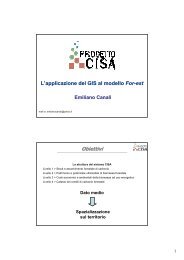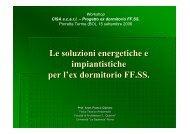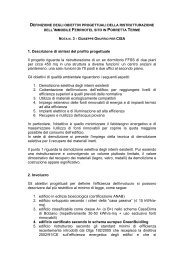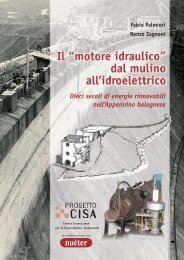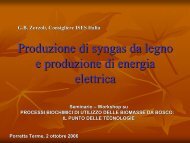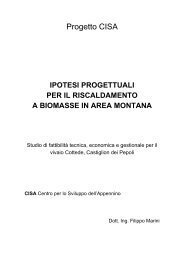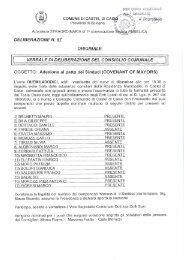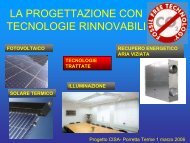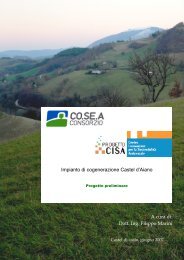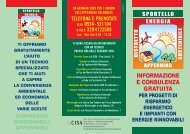Le linee guida per la contabilizzazione delle riduzione di CO2 degli ...
Le linee guida per la contabilizzazione delle riduzione di CO2 degli ...
Le linee guida per la contabilizzazione delle riduzione di CO2 degli ...
You also want an ePaper? Increase the reach of your titles
YUMPU automatically turns print PDFs into web optimized ePapers that Google loves.
Verso Copenhagen: <strong>linee</strong> <strong>guida</strong> <strong>per</strong> <strong>la</strong> <strong>contabilizzazione</strong> <strong>delle</strong> riduzioni <strong>di</strong> <strong>CO2</strong> <strong>degli</strong> enti locali 55<br />
INTERVENTI<br />
DIRETTI<br />
Descrizione dei<br />
possibili<br />
interventi<br />
Buone pratiche<br />
Metodologia<br />
utilizzata<br />
D. FORESTAZIONE E VERDE PUBBLICO<br />
Piantumazione alberi: Intervento <strong>di</strong> <strong>riduzione</strong> <strong>di</strong> <strong>CO2</strong> atmosferica tramite<br />
assorbimento <strong>per</strong> mezzo <strong>di</strong> vegetazione (ve<strong>di</strong> schedaD1)<br />
Il Protocollo <strong>di</strong> Kyoto, nel delineare una strategia <strong>di</strong> contenimento <strong>delle</strong> emissioni <strong>di</strong><br />
gas serra, considera in maniera significativa i contributi <strong>delle</strong> aree forestali nel<strong>la</strong><br />
mo<strong>di</strong>ficazione del bi<strong>la</strong>ncio fra emissione e assorbimento <strong>di</strong> <strong>CO2</strong>. <strong>Le</strong> foreste sono<br />
infatti l'ecosistema in grado <strong>di</strong> immagazzinare il maggior quantitativo <strong>di</strong> carbonio. A<br />
livello mon<strong>di</strong>ale esse fissano globalmente circa 1.146 miliar<strong>di</strong> <strong>di</strong> ton <strong>di</strong> C (Kimmins,<br />
1997). Pertanto, una mirata gestione del patrimonio boschivo esistente e <strong>la</strong><br />
realizzazione <strong>di</strong> nuovi impianti forestali possono contribuire a mitigare l'effetto<br />
serra. Infatti le foreste e le aree ver<strong>di</strong> in generale sono in grado <strong>di</strong> fissare <strong>la</strong> <strong>CO2</strong><br />
atmosferica tramite il processo <strong>di</strong> fotosintesi che si attiva grazie al<strong>la</strong> ra<strong>di</strong>azione<br />
so<strong>la</strong>re e assimi<strong>la</strong>re il carbonio in essa contenuto. La promozione del<strong>la</strong> fissazione<br />
del<strong>la</strong> <strong>CO2</strong> specialmente dagli ecosistemi agro forestali viene dunque<br />
partico<strong>la</strong>rmente caldeggiata come uno dei principali strumenti <strong>di</strong> lotta al<strong>la</strong><br />
<strong>riduzione</strong> dei gas serra. La capacità <strong>di</strong> un ecosistema forestale <strong>di</strong> assorbire <strong>CO2</strong><br />
dall’atmosfera <strong>di</strong>pende dalle sue caratteristiche ed è in generale molto <strong>di</strong>verso da<br />
una specie arborico<strong>la</strong> all’altra.<br />
Castello <strong>di</strong> Argile (BO): 76,83 ton <strong>CO2</strong><br />
Nel 2007 il Comune <strong>di</strong> Castello <strong>di</strong> Argile ha piantato 20 ettari <strong>di</strong> specie autoctone<br />
nel Parco del<strong>la</strong> fiumana, ottenendo, grazie a questa azione, un assorbimento <strong>di</strong><br />
76,83 tonnel<strong>la</strong>te <strong>di</strong> <strong>CO2</strong> all’anno.<br />
Il problema principale da risolvere in questo ambito è <strong>la</strong> determinazione del<strong>la</strong><br />
quantità <strong>di</strong> carbonio che ogni anno viene accumu<strong>la</strong>ta dal<strong>la</strong> biomassa forestale<br />
(PPN). Per conoscere il contenuto <strong>di</strong> carbonio in un ettaro <strong>di</strong> foresta si sono<br />
utilizzate le informazioni presenti nel Manuale Nazionale dei Fattori <strong>di</strong> Emissione,<br />
redatto nel 2002 da ANPA e CTN-ACE (Centro Tematico Nazionale Atmosfera Clima<br />
ed Emissioni).<br />
Tale valore è stato calco<strong>la</strong>to tenendo conto <strong>delle</strong> <strong>di</strong>rettive dell’IPCC nel suo Good<br />
Practice Guidance for Land Use, Land-Use Change and Forestry (2003), in cui viene<br />
calco<strong>la</strong>to <strong>la</strong> PPN <strong>per</strong> le varie zone climatiche mon<strong>di</strong>ali (tem<strong>per</strong>ata, tropicale, ecc.)<br />
considerando le specie forestali tipiche <strong>di</strong> ogni zona (foreste tem<strong>per</strong>ate, foreste<br />
tropicali, conifere, ecc). Per L’Italia tale valore (utilizzato anche dall’ARPA dell’Emilia<br />
Romagna <strong>per</strong> <strong>la</strong> stesura dell’Inventario regionale <strong>delle</strong> emissioni <strong>di</strong> anidride<br />
carbonica e valutazione <strong>degli</strong> effetti <strong>delle</strong> politiche <strong>di</strong> <strong>riduzione</strong> <strong>delle</strong> emissioni <strong>di</strong><br />
gas serra, 2004) è risultato pari a:<br />
PPN (Produzione primaria netta) = 1.047,78 (Kg/Ha * anno)<br />
Da cui: RL<strong>CO2</strong> = PPN · K<strong>CO2</strong> · A [kg<strong>CO2</strong>/anno]<br />
e A* 3,84186 [t<strong>CO2</strong>/anno]<br />
<strong>Le</strong> specie arboree utilizzabili <strong>per</strong> un intervento <strong>di</strong> forestazione sono molteplici:<br />
abete, pino montano, carpini, castagno, cerro, faggio, roverel<strong>la</strong> e altre <strong>la</strong>tifoglie<br />
(specie autoctone dell’Emilia Romagna, come rilevato dall’indagine condotta <strong>per</strong><br />
re<strong>di</strong>gere l’Inventario Forestale Regionale). Naturalmente non si esclude l’utilizzo <strong>di</strong><br />
altre specie non presenti nell’elenco.



